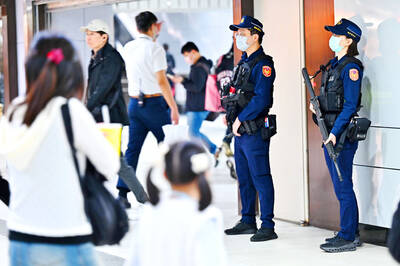Taiwan Semiconductor Manufacturing Co (TSMC, 台積電) has achieved early production yields at its first plant in Arizona that surpass similar factories back home, a significant breakthrough for a US expansion project initially dogged by delays and worker strife.
The share of chips manufactured at TSMC’s facility in Phoenix that are usable is about 4 percentage points higher than comparable facilities in Taiwan, Rick Cassidy, president of TSMC’s US division, told listeners on a webinar on Wednesday, according to a person who participated.
The success rate, or yield, is a critical measure in the semiconductor industry because it determines whether companies would be able to cover the enormous costs of a chip plant.

Photo: Bloomberg
The accomplishment is a sign of progress for Washington’s efforts to revitalize semiconductor manufacturing in the US.
TSMC, the main chip manufacturing partner for Nvidia Corp and Apple Inc, is in line to win US$6.6 billion in US government grants and US$5 billion in loans — plus 25 percent tax credits — to build three fabs in Arizona. The award, like almost all others from the 2022 CHIPS and Science Act, is not yet finalized.
The two other chipmakers at the heart of the tech strategy of US President Joe Biden’s administration — Intel Corp and Samsung Electronics Co — have struggled in the past few months.
Intel, slated to be the biggest beneficiary of the CHIPS Act, is under such severe financial pressure that it is delaying global projects and considering selling assets.
Meanwhile, TSMC has been on a roll.
Its shares reached a record high this month after the chipmaker topped quarterly estimates and raised its target for revenue growth this year.
The latest yield advancement is notable for TSMC, because it has historically kept the most advanced and efficient plants in Taiwan.
Its Arizona site got off to a rocky start, as the company could not find enough skilled staff to install advanced equipment, and workers struggled with safety and management issues.
TSMC reached an accord with construction labor unions late last year.
The chipmaker originally planned to have its first Arizona plant start full production this year, but pushed back the target to next year over the labor issues. It later delayed the start date for its second fab to 2027 or 2028, from an initial target of 2026. That fueled concerns that the company might not be able to make chips in the US as efficiently as in Taiwan.
TSMC could now be keen to expand its US presence further, depending in part on the possibility of more US government backing, Cassidy said, citing early conversations in Washington about a second CHIPS Act.
There is room for at least six fabs at the Phoenix complex.

TRAGEDY STRIKES TAIPEI: The suspect died after falling off a building after he threw smoke grenades into Taipei Main Station and went on a killing spree in Zhongshan A 27-year-old suspect allegedly threw smoke grenades in Taipei Main Station and then proceeded to Zhongshan MRT Station in a random killing spree that resulted in the death of the suspect and two other civilians, and seven injured, including one in critical condition, as of press time last night. The suspect, identified as a man surnamed Chang Wen (張文), allegedly began the attack at Taipei Main Station, the Taipei Fire Department said, adding that it received a report at 5:24pm that smoke grenades had been thrown in the station. One man in his 50s was rushed to hospital after a cardiac arrest

SAFETY FIRST: Double the number of police were deployed at the Taipei Marathon, while other cities released plans to bolster public event safety Authorities across Taiwan have stepped up security measures ahead of Christmas and New Year events, following a knife and smoke bomb attack in Taipei on Friday that left four people dead and 11 injured. In a bid to prevent potential copycat incidents, police deployments have been expanded for large gatherings, transport hubs, and other crowded public spaces, according to official statements from police and city authorities. Taipei Mayor Chiang Wan-an (蔣萬安) said the city has “comprehensively raised security readiness” in crowded areas, increased police deployments with armed officers, and intensified patrols during weekends and nighttime hours. For large-scale events, security checkpoints and explosives

A car bomb killed a senior Russian general in southern Moscow yesterday morning, the latest high-profile army figure to be blown up in a blast that came just hours after Russian and Ukrainian delegates held separate talks in Miami on a plan to end the war. Kyiv has not commented on the incident, but Russian investigators said they were probing whether the blast was “linked” to “Ukrainian special forces.” The attack was similar to other assassinations of generals and pro-war figures that have either been claimed, or are widely believed to have been orchestrated, by Ukraine. Russian Lieutenant General Fanil Sarvarov, 56, head

PUBLIC SAFETY: The premier said that security would be tightened in transport hubs, while President Lai commended the public for their bravery The government is to deploy more police, including rapid response units, in crowded public areas to ensure a swift response to any threats, President William Lai (賴清德) said yesterday after a knife attack killed three people and injured 11 in Taipei the previous day. Lai made the remarks following a briefing by the National Police Agency on the progress of the investigation, saying that the attack underscored the importance of cooperation in public security between the central and local governments. The attack unfolded in the early evening on Friday around Taipei Main Station’s M7 exit and later near the Taipei MRT’s Zhongshan